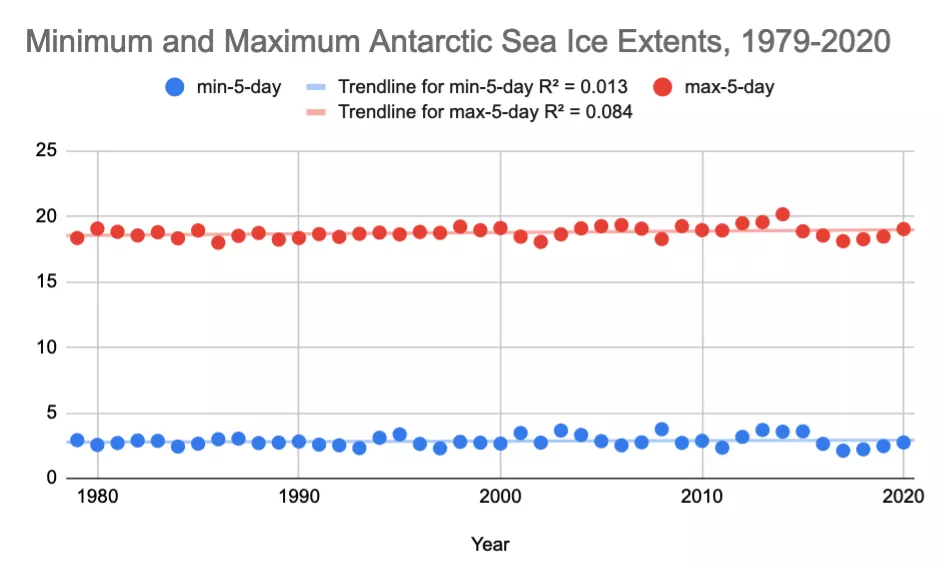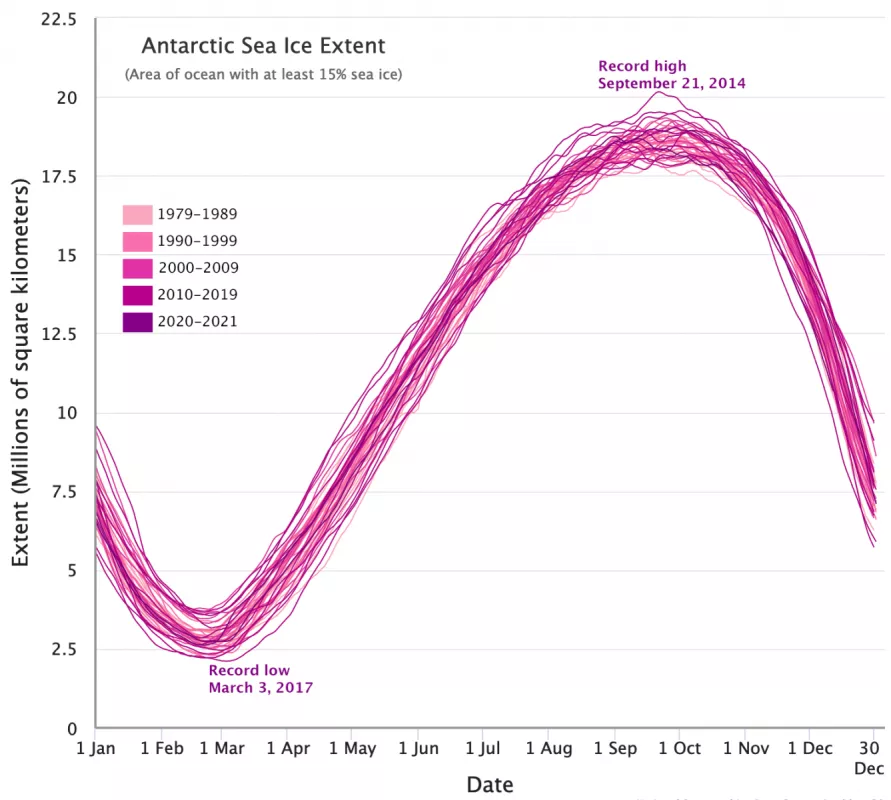Besides occurring on the opposite side of the globe, Antarctic sea ice differs from Arctic sea ice in a couple of respects. First, the Arctic is an ocean basin largely surrounded by land whereas the Antarctic is a continent surrounded by ocean, and these differing geographies affect sea ice. Second, while Arctic sea ice has declined directly in relation to warming climate, Antarctic sea ice has shown no clear trend.
Polar opposites
In both the Northern and Southern Hemispheres, sea ice grows throughout the fall and winter, and melts throughout the spring and summer. Since the Northern and Southern Hemispheres experience opposite seasons, however, Arctic and Antarctic sea ice grow and retreat at opposite times of year.
If opposite seasons were the only difference between the Arctic and Antarctic, sea ice in each hemisphere could mirror each other’s highs and lows. But the polar regions’ land-ocean configurations also differentiate them.
Satellites have observed sea ice growth and retreat for decades. The 1981 to 2010 Antarctic average minimum extent was 2.8 million square kilometers, lower than the Arctic’s 6.3 million square kilometers. The 1981 to 2010 Antarctic average maximum extent was 18.6 million square kilometers, higher than the Arctic’s 15.5 million square kilometers. Antarctica’s higher highs and lower lows have much to do with geography.
Since the North Pole is covered by ocean, ice can blanket the ocean surface, covering the northernmost latitudes year round. But the coastlines of Eurasia, North America, and Greenland constrain Arctic sea ice’s southward growth in autumn and winter.
In contrast, Antarctic sea ice cannot form any closer to the South Pole than the Arctic coastline allows. But Antarctic sea ice is free to stretch toward the equator as far as cold conditions allow. No land blocks its northward expansion.
Although Antarctic ice has more room to grow in winter, it is not uncommon for the ice to melt away completely along parts of the Antarctic coastline in summer. Forming farther from the pole, Antarctic sea ice is less likely to survive the summer melt season. For that reason, the Southern Hemisphere has less old, thick, multiyear sea ice than the Northern Hemisphere.
Off-trend Antarctic
Since the start of the satellite record in November 1978, Arctic sea ice has shown a clear declining trend, especially in summer and autumn, but Antarctic sea ice has not. Instead, Antarctic sea ice has shown substantial year-to-year variability.
The highest maximum and lowest minimum extents on record for Antarctic sea ice happened within a few years of each other. Antarctic sea ice reaches its annual maximum in September or October, and its annual minimum in February or March. The highest winter maximum occurred in September 2014, and the lowest summer minimum occurred in March 2017.
The absence of a significant declining trend in Antarctic sea ice does not cast doubt on the reality of global warming. But it shows how rising global temperatures do not affect the Southern Hemisphere in the same way they affect the Northern Hemisphere.
Relationship status: complicated
A significant factor in Arctic sea ice decline is Arctic amplification: temperatures rising north of 60°N at roughly twice the rate of global temperatures. Multiple factors drive this amplification effect. One of them is the decline in spring snow cover on landmasses surrounding the Arctic Ocean, which enables sunlight to warm the region faster.
Antarctica, in contrast, is surrounded by the vast Southern Ocean. Antarctic sea ice extent is likely driven primarily by natural variability related to the Southern Ocean.
Perhaps the most significant natural oscillation affecting Antarctic sea ice is the Southern Annual Mode, or SAM. SAM is also known as the Antarctic Oscillation, and it is the Southern Hemisphere version of the Arctic Oscillation.
SAM is a westerly wind pattern around Antarctica, and it has implications for weather as far away as southeastern Australia. Closer to Antarctica, SAM can nudge sea ice extent up or down. SAM is affected by El Niño-Southern Oscillation conditions, and it is also influenced by the Amundsen Sea Low, which has a complex interaction with sea ice movement west of the Antarctic Peninsula. Anthropogenic global warming partly affects SAM, tending to push it into more frequent positive mode. When SAM is in positive mode, westerly winds around Antarctica can increase Antarctic sea ice extent. However, relationships between climate warming and SAM, and between SAM and sea ice, are anything but straightforward.
The absence of a clear declining trend in Antarctic sea ice does not mean global warming is not happening. At present, though, the impact of global warming on Antarctic sea ice is messy, and natural variability likely plays a bigger role in Antarctic sea ice extent. Year-to-year variations still overwhelm any long-term trend.
The impact of warming on other kinds of Antarctic ice is clearer. Multiple studies indicate the massive Antarctic Ice Sheet is losing mass. Meanwhile, ice shelf disintegration has accelerated glacier flow off the continent, and Antarctica’s Thwaites Glacier loses about 50 billion tons of ice per year. The Antarctic may respond differently than the Arctic to rising global temperatures, but the Antarctic still responds.
References
Crosta, X., J. Etourneau, L.C. Orme, Q. Dalaiden, P. Campagne, D. Swingedouw, H. Goosse, G. Massé, A. Miettinen, R.M. McKay, R.B. Dunbar, C. Escutia, and M. Ikehara. 2021. Multi-decadal trends in Antarctic sea-ice extent driven by ENSO–SAM over the last 2,000 years. Nature Geoscience, 14: 156-160. https://doi.org/10.1038/s41561-021-00697-1
Arblaster, J.M., and G.A. Meehl. 2005. Contributions of external forcings to Southern Annual Mode trends. Journal of Climate, 19: 2896-2905. https://doi.org/10.1175/JCLI3774.1


